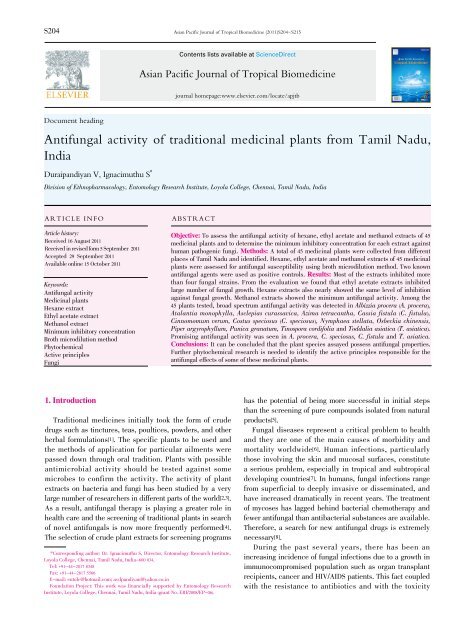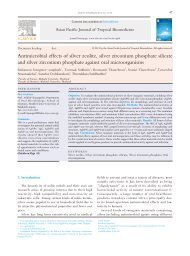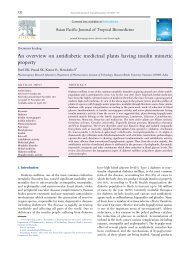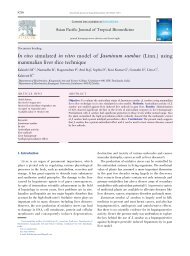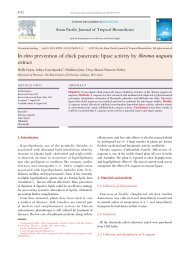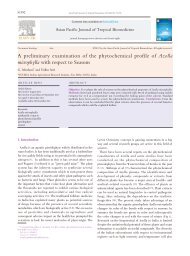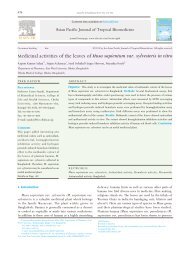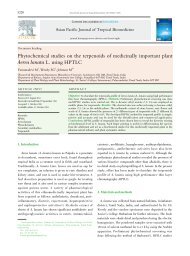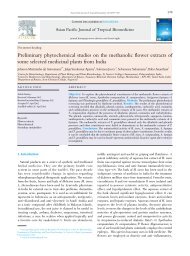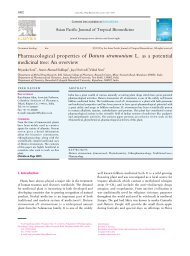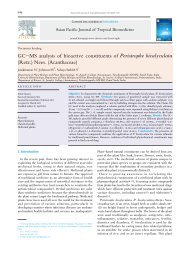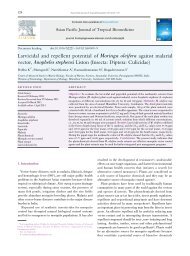Antifungal activity of traditional medicinal plants from Tamil - Apjtb.com
Antifungal activity of traditional medicinal plants from Tamil - Apjtb.com
Antifungal activity of traditional medicinal plants from Tamil - Apjtb.com
You also want an ePaper? Increase the reach of your titles
YUMPU automatically turns print PDFs into web optimized ePapers that Google loves.
S204<br />
Document heading<br />
<strong>Antifungal</strong> <strong>activity</strong> <strong>of</strong> <strong>traditional</strong> <strong>medicinal</strong> <strong>plants</strong> <strong>from</strong> <strong>Tamil</strong> Nadu,<br />
India<br />
Duraipandiyan V, Ignacimuthu S *<br />
Asian Pacific Journal <strong>of</strong> Tropical Biomedicine (2011)S204-S215<br />
Asian Pacific Journal <strong>of</strong> Tropical Biomedicine<br />
journal homepage:www.elsevier.<strong>com</strong>/locate/apjtb<br />
Division <strong>of</strong> Ethnopharmacology, Entomology Research Institute, Loyola College, Chennai, <strong>Tamil</strong> Nadu, India<br />
ARTICLE INFO ABSTRACT<br />
Article history:<br />
Received 16 August 2011<br />
Received in revised form 5 September 2011<br />
Accepted 29 September 2011<br />
Available online 15 October 2011<br />
Keywords:<br />
<strong>Antifungal</strong> <strong>activity</strong><br />
Medicinal <strong>plants</strong><br />
Hexane extract<br />
Ethyl acetate extract<br />
Methanol extract<br />
Minimum inhibitory concentration<br />
Broth microdilution method<br />
Phytochemical<br />
Active principles<br />
Fungi<br />
1. Introduction<br />
Traditional medicines initially took the form <strong>of</strong> crude<br />
drugs such as tinctures, teas, poultices, powders, and other<br />
herbal formulations[1]. The specific <strong>plants</strong> to be used and<br />
the methods <strong>of</strong> application for particular ailments were<br />
passed down through oral tradition. Plants with possible<br />
antimicrobial <strong>activity</strong> should be tested against some<br />
microbes to confirm the <strong>activity</strong>. The <strong>activity</strong> <strong>of</strong> plant<br />
extracts on bacteria and fungi has been studied by a very<br />
large number <strong>of</strong> researchers in different parts <strong>of</strong> the world[2,3].<br />
As a result, antifungal therapy is playing a greater role in<br />
health care and the screening <strong>of</strong> <strong>traditional</strong> <strong>plants</strong> in search<br />
<strong>of</strong> novel antifungals is now more frequently performed[4].<br />
The selection <strong>of</strong> crude plant extracts for screening programs<br />
*Corresponding author: Dr. Ignacimuthu S, Director, Entomology Research Institute,<br />
Loyola College, Chennai, <strong>Tamil</strong> Nadu, India-600 034.<br />
Tel: +91-44-2817 8348<br />
Fax: +91-44-2817 5566<br />
E-mail: entolc@hotmail.<strong>com</strong>; avdpandiyan@yahoo.co.in<br />
Foundation Project: This work was financially supported by Entomology Research<br />
Institute, Loyola College, Chennai, <strong>Tamil</strong> Nadu, India (grant No. ERI/2008/EP-06).<br />
Contents lists available at ScienceDirect<br />
Objective: To assess the antifungal <strong>activity</strong> <strong>of</strong> hexane, ethyl acetate and methanol extracts <strong>of</strong> 45<br />
<strong>medicinal</strong> <strong>plants</strong> and to determine the minimum inhibitory concentration for each extract against<br />
human pathogenic fungi. Methods: A total <strong>of</strong> 45 <strong>medicinal</strong> <strong>plants</strong> were collected <strong>from</strong> different<br />
places <strong>of</strong> <strong>Tamil</strong> Nadu and identified. Hexane, ethyl acetate and methanol extracts <strong>of</strong> 45 <strong>medicinal</strong><br />
<strong>plants</strong> were assessed for antifungal susceptibility using broth microdilution method. Two known<br />
antifungal agents were used as positive controls. Results: Most <strong>of</strong> the extracts inhibited more<br />
than four fungal strains. From the evaluation we found that ethyl acetate extracts inhibited<br />
large number <strong>of</strong> fungal growth. Hexane extracts also nearly showed the same level <strong>of</strong> inhibition<br />
against fungal growth. Methanol extracts showed the minimum antifungal <strong>activity</strong>. Among the<br />
45 <strong>plants</strong> tested, broad spectrum antifungal <strong>activity</strong> was detected in Albizzia procera (A. procera),<br />
Atalantia monophylla, Asclepias curassavica, Azima tetracantha, Cassia fistula (C. fistula),<br />
Cinnomomum verum, Costus speciosus (C. speciosus), Nymphaea stellata, Osbeckia chinensis,<br />
Piper argyrophyllum, Punica granatum, Tinospora cordifolia and Toddalia asiatica (T. asiatica).<br />
Promising antifungal <strong>activity</strong> was seen in A. procera, C. speciosus, C. fistula and T. asiatica.<br />
Conclusions: It can be concluded that the plant species assayed possess antifungal properties.<br />
Further phytochemical research is needed to identify the active principles responsible for the<br />
antifungal effects <strong>of</strong> some <strong>of</strong> these <strong>medicinal</strong> <strong>plants</strong>.<br />
has the potential <strong>of</strong> being more successful in initial steps<br />
than the screening <strong>of</strong> pure <strong>com</strong>pounds isolated <strong>from</strong> natural<br />
products[5].<br />
Fungal diseases represent a critical problem to health<br />
and they are one <strong>of</strong> the main causes <strong>of</strong> morbidity and<br />
mortality worldwide[6]. Human infections, particularly<br />
those involving the skin and mucosal surfaces, constitute<br />
a serious problem, especially in tropical and subtropical<br />
developing countries[7]. In humans, fungal infections range<br />
<strong>from</strong> superficial to deeply invasive or disseminated, and<br />
have increased dramatically in recent years. The treatment<br />
<strong>of</strong> mycoses has lagged behind bacterial chemotherapy and<br />
fewer antifungal than antibacterial substances are available.<br />
Therefore, a search for new antifungal drugs is extremely<br />
necessary[8].<br />
During the past several years, there has been an<br />
increasing incidence <strong>of</strong> fungal infections due to a growth in<br />
immuno<strong>com</strong>promised population such as organ transplant<br />
recipients, cancer and HIV/AIDS patients. This fact coupled<br />
with the resistance to antibiotics and with the toxicity
Duraipandiyan V and Ignacimuthu S/Asian Pacific Journal <strong>of</strong> Tropical Biomedicine (2011)S204-S215 S205<br />
during prolonged treatment with several antifungal drugs[9]<br />
has been the reason for an extended search for newer drugs<br />
to treat opportunistic fungal infections[10].<br />
Pathogenic fungi, dermatophytes, have the ability to<br />
invade keratinized tissues <strong>of</strong> animals and humans and<br />
cause a disease, dermatophytosis, which is the <strong>com</strong>monest<br />
human contagious fungal disease[11,12]. Trichophyton<br />
rubrum (T. rubrum ) is the most prevalent pathogenic fungus<br />
worldwide and it represents 80% <strong>of</strong> clinical isolates[13]. Due<br />
to the increasing development <strong>of</strong> drug resistance in human<br />
pathogens as well as the appearance <strong>of</strong> undesirable effect<br />
<strong>of</strong> certain antimicrobial agents, there is a need to search for<br />
new antifungal agent without toxicity and side effect.<br />
Plant extracts or plant-derived <strong>com</strong>pounds are likely to<br />
provide a valuable source <strong>of</strong> new <strong>medicinal</strong> agents[14,15].<br />
Infectious diseases, particularly skin and mucosal<br />
infections, are <strong>com</strong>mon in most <strong>of</strong> the tribal inhabitants<br />
due to lack <strong>of</strong> sanitation, potable water and awareness <strong>of</strong><br />
hygienic food habits. An important group <strong>of</strong> these skin<br />
pathogens are the fungi, among which dermatophytes and<br />
Candida spp are prominent[16,17]. Antimicrobial properties<br />
<strong>of</strong> certain Indian <strong>medicinal</strong> <strong>plants</strong> were reported based on<br />
folklore information[18-25], and a few attempts were made on<br />
inhibitory <strong>activity</strong> against certain pathogenic bacteria and<br />
fungi.<br />
In the present study, the antifungal activities <strong>of</strong> hexane,<br />
ethyl acetate and chlor<strong>of</strong>orm extracts <strong>of</strong> 45 <strong>medicinal</strong> <strong>plants</strong><br />
were investigated against dermatophytes and opportunistic<br />
pathogens.<br />
2. Materials and methods<br />
2.1. Chemicals and media<br />
Dimethyl sulphoxide (DMSO), Sabouraud dextrose agar<br />
(SDA), Sabouraud dextrose broth (SDB) were obtained <strong>from</strong><br />
Himedia, Mumbai, India. The organic solvents i.e., hexane,<br />
ethyl acetate and methanol were obtained <strong>from</strong> Rankem<br />
Company, India. The antifungal agent fluconazole was<br />
obtained <strong>from</strong> Himedia, Mumbai.<br />
2.2. Collection <strong>of</strong> <strong>plants</strong> and identification<br />
The selection <strong>of</strong> the species used in this study was mainly<br />
based on their ethnomedical evidence (literature) <strong>of</strong> use for<br />
conditions related to microbial infections. These include<br />
skin infections, healing <strong>of</strong> wounds, diarrhoea and fever,<br />
etc. Some <strong>plants</strong> without ethnomedical precedents but not<br />
previously studied were also included.<br />
The <strong>plants</strong> were collected <strong>from</strong> different places <strong>of</strong> <strong>Tamil</strong><br />
Nadu and authenticated by a plant taxonomist <strong>from</strong> the<br />
Department <strong>of</strong> Botany, Loyola College, Chennai. A voucher<br />
specimen (ERILC 1-45) is deposited at the herbarium <strong>of</strong><br />
Entomology Research Institute, Loyola College, Chennai. The<br />
following 45 <strong>plants</strong> were selected for the present study.<br />
Acalypha fruticosa (A. fruticosa) Forsk, Achyranthes<br />
bidentata Blume, Albizzia procera (A. procera) (Roxb.)<br />
Benth, Aristolochia tagala (A. tagala) Cham, Asclepias<br />
curassavica (A. curassavica) L, Atalantia monophylla (A.<br />
monophylla) Correa, Azima tetracantha (A. tetracantha)<br />
Lam, Bauhinia tomentosa (B. tomentosa) L, Biophytum<br />
sensitivum (B. sensitivum) DC, Caesalpinia pulcherrima (C.<br />
pulcherrima) Swartz, Cassia fistula (C. fistula) L, Cassia<br />
alata (C. alata) Linn, Cassia auriculata (C. auriculata)<br />
Linn, Casearia elliptica (C. elliptica) Willd, Cinnomomum<br />
verum (C. verum) Presl, Costus speciosus (C. speciosus) Sm,<br />
Couroupita guianensis (C. guianensis) Aublet, Croton<br />
sparsiflorus (C. sparsiflorus) Morong, Diospyros ebenum (D.<br />
ebenum) Koenig, Dodonaea angustifolia (D. angustifolia),<br />
Elephantopus scaber (E. scaber) L, Gomphrena celosioides (G.<br />
celosioides) Baan, Hydnocarpus alpina (H. alpina) Wt, Hyptis<br />
suaveolens (H. suaveolens) Poit, Ichnocarpus frutescens (I.<br />
frutescens) (L.) R.Br, Mundulea sericea (M. sericea) Chevel,<br />
Nymphaea stellata (N. stellata) Willd, Ocimum basilicum<br />
(O. basilicum) Linn, Osbeckia chinensis (O. chinensis) Linn,<br />
Olax scandens (O. scandens) Roxb, Ophiorrhiza mungos (O.<br />
mungos) Linn, Peltophorum pterocarpum (P. pterocarpum)<br />
(DC.), Pergularia daemia (P. daemia)R.Br, Pterolobium<br />
hexapetalum Roth, Plumbago zeylanica (P. zeylanica) Linn,<br />
Piper brachystachyum (P. brachystachyum) Wall, Piper<br />
argyrophyllum (P. argyrophyllum ) Miq, Punica granatum<br />
(P. granatum), Syzygium cumini (S. cumini) (DC.), Syzygium<br />
lineare (S. lineare) Wall, Sphaeranthus indicus (S. indicus)<br />
L, Solanum xanthocarpum (S. xanthocarpum) Sch.&wendl,<br />
Tinospora Cordifolia (T. cordifolia) Miers, Toddalia asiatica<br />
(T. asiatica) Lamk and Zizyphus oenoplia (Z. oenoplia) Mill.<br />
2.3. Preparation <strong>of</strong> plant extracts<br />
The <strong>plants</strong> were collected and shade dried at room<br />
temperature and ground in a manual mill. The powder was<br />
extracted with hexane for a period <strong>of</strong> 48 h. The extract was<br />
filtered through a Buchner funnel with Whatman No.1 filter<br />
paper. The filtrate was evaporated to dryness under reduced<br />
pressure using rotary evaporator. The remaining residue<br />
<strong>of</strong> the plant material was extracted with ethyl acetate and<br />
methanol sequentially in a similar manner. The extracts<br />
were stored at 4 曟 until further use.<br />
2.4. Tested fungi<br />
The following fungi were used for experiments:<br />
Trichophyton rubrum (T. rubrum) MTCC 296, T. rubrum<br />
57/01, Trichophyton mentagrophytes (T. mentagrophytes)<br />
66/01, Trichophyton simii (T. simii) 110/02, Epidermophyton<br />
floccosum (E. floccosum) 73/01, Scopulariopsis sp. 101/01<br />
Aspergillus niger (A. niger) MTCC 1344, Botrytis cinerea (B.<br />
cinerea), Curvularia lunata (C. lunata) 46/01, Magnaporthe<br />
grisea (M. grisea) and Candida albicans (C. albicans) MTCC<br />
227.
S206<br />
2.5. Preparation <strong>of</strong> fungal spore<br />
Duraipandiyan V and Ignacimuthu S/Asian Pacific Journal <strong>of</strong> Tropical Biomedicine (2011)S204-S215<br />
The filamentous fungi were grown on SDA slants at 28 曟 for<br />
10 days and the spores were collected using sterile doubled<br />
distilled water and homogenized. Yeast was grown on SDB at<br />
28 曟 for 48 h.<br />
2.6. <strong>Antifungal</strong> assays<br />
The antifungal <strong>activity</strong> was performed according to the<br />
standard reference method[26]. The extracts were dissolved in<br />
2% DMSO. The initial concentration <strong>of</strong> extract was 1 mg/mL.<br />
The initial test concentration was serially diluted two-fold.<br />
Each well was inoculated with 5 毺L <strong>of</strong> suspension containing<br />
104 spore/mL <strong>of</strong> fungi. The antifungal agent fluconazole was<br />
included in the assays as positive control; the plates were<br />
incubated for 24 h to 72 h at 27 曟 for dermatophytes strains.<br />
MIC was defined as the lowest extract concentration showing<br />
no visible fungal growth after incubation time.<br />
3. Results<br />
Table 1<br />
Traditional uses, <strong>medicinal</strong> properties and chemical constituents <strong>of</strong> selected <strong>medicinal</strong> <strong>plants</strong>.<br />
The <strong>traditional</strong> uses <strong>of</strong> selected <strong>medicinal</strong> <strong>plants</strong> are<br />
described in Table 1. Results <strong>of</strong> antifungal <strong>activity</strong> are<br />
summarized in Table 2. Of the 45 <strong>plants</strong> tested, most <strong>of</strong> the<br />
<strong>plants</strong> showed varying degree <strong>of</strong> antifungal <strong>activity</strong>. Most <strong>of</strong><br />
the extracts inhibited more than four fungal strains. From<br />
the evaluation we found that ethyl acetate extracts inhibited<br />
large number <strong>of</strong> fungi. Hexane extracts also nearly showed<br />
the same level <strong>of</strong> inhibition against fungi. Methanol extracts<br />
showed minimum antifungal <strong>activity</strong>. Some <strong>plants</strong> were<br />
moderately active. We have tested two types <strong>of</strong> fungal strains<br />
such as, T. mentagrophytes, T. rubrum 296, T. rubrum 57, T.<br />
simii, E. floccosum, C. albicans and Scopulariopsis sp which<br />
are dermatophyte and A. niger, B. cinerea, M. grisea and C.<br />
lunata which are opportunistic pathogen.<br />
The dermatophytes cause skin eruptions which last<br />
for long time. The selected <strong>plants</strong> are widely used to<br />
treat skin diseases and diarrhoea. Broad spectrum <strong>of</strong><br />
antifungal <strong>activity</strong> was detected among tested <strong>plants</strong> <strong>of</strong> A.<br />
procera, A. monophylla, A. curassavica, A. tetracantha, C.<br />
Name <strong>of</strong> the <strong>plants</strong> Local name Part used Medicinal uses Chemicals constituents References<br />
A. fruticosa L<br />
Siru chinni Leaves, root Antioxidant, anti-inflammatory, skin Alkaloid, Flavonoids [27,28]<br />
(Euphorbiaceae)<br />
diseases, dysentery<br />
Achyranthes bidendata Sivappu naayuruvi Leaves, root, stem Roots are dried and ground into -<br />
[29,30]<br />
(Amaranthaceae)<br />
a powder or used in decoctions,<br />
asthma, pyorrhea, Anti-HIV <strong>activity</strong><br />
A. procera (Roxb.) Benth<br />
(Leguminosae)<br />
A. tagala Cham.<br />
(Aristolochiaceae)<br />
A. curassavica L.<br />
(Asclepidaceae)<br />
A. monophylla Correa.<br />
(Rutaceae)<br />
A. tetracantha Lam<br />
Salvadoraceae<br />
Bauhinia tomentosa L.<br />
(Caesalpiniaceae)<br />
B. sensitivum DC<br />
Oxzalidaceae<br />
Caesalpinia pulcherima<br />
Swarts. (Caesalpiniaceae)<br />
C. elliptica Willd.<br />
(Samydaceae)<br />
C. alata L<br />
(Caesalpiniaceae)<br />
C. auriculata L<br />
(Caesalpiniaceae)<br />
C. fistula L<br />
(Caesalpiniaceae)<br />
Konda vaghe Leaves , bark Leaves are used as insecticides, The -<br />
leaves are also used to ulcer<br />
-<br />
- Leaves, root The roots are used to skin diseases - [31]<br />
Pallai chedi Leaves The juice <strong>of</strong> A. curassavica is used<br />
against roundworm infestation, as<br />
an anthelmintic, haemostatic and in<br />
gonorrhoea<br />
-<br />
[32]<br />
Kattuelumicaapazham. Leaves , bark Leaves <strong>of</strong> A. monophylla are used<br />
to treat rheumatism, paralysis as<br />
antidysentric and antipyretic<br />
-<br />
[33,34]<br />
Changam Leaves Cough, asthma, ulcer, Diarrhea Azimine, azcarpine,<br />
carpaine, friedelin<br />
[35]<br />
Kanchini, Thiruvatti Leaves, root, seed Antidysenteric and anthelmintic,<br />
dried leaves, buds and young flowers<br />
are prescribed in dysentery<br />
-<br />
-<br />
Tintaanaalee Whole plant Diabetes, asthma Phenolic <strong>com</strong>pounds [36]<br />
- Leaves, bark, root Diarrhoea and dysentery,<br />
rheumatism, skin infections and as<br />
anti-ulcerogenic<br />
Kadichai, Kutti Leaves , root, bark in <strong>traditional</strong> medicine against<br />
malaria<br />
Seemai agathi Leaves Leprosy and liver disease,<br />
antihelminthic, antibacterial,<br />
laxative, diuretic, for treatment <strong>of</strong><br />
snakebites and uterine disorders<br />
Aavaarai Leaves Root is used to treat skin diseases,<br />
Immunostimulant and Endocrine<br />
stimulant, Antiviral and anti<br />
spasmodic<br />
Sarakonnai Flower Diarrhea and skin disorder,<br />
antimicrobial, antidiabetic,<br />
antioxidant<br />
-<br />
-<br />
Kaempferol,<br />
naringenin, guercetin<br />
Triterpenoid,<br />
glycosides<br />
Anthraquinone,<br />
glycosides, fistulic<br />
acid, benzoic acid<br />
[37,38]<br />
[39]<br />
[40,41]<br />
[42]<br />
[43]
Table 1, continued<br />
C. verum Presl.<br />
(Lauraceae)<br />
C. speciosus Sm.<br />
(Zingiferaceae )<br />
C. guianensis Aubl.<br />
(Lecythidaceae)<br />
Diospyros ebenum Koenig<br />
(Ebinaceae)<br />
D. angustifolia L.<br />
(Sabindaceae)<br />
Elephentopus scaber L<br />
(Astreaceae)<br />
Duraipandiyan V and Ignacimuthu S/Asian Pacific Journal <strong>of</strong> Tropical Biomedicine (2011)S204-S215 S207<br />
Lavangampattai Leaves, bark <strong>Antifungal</strong>, antibacterial Cinnamaldehyde [44]<br />
- Rhizome, leaves burningsensation, constipation, Costunolide,<br />
leprosy, worminfection, skindiseases, eremanthin<br />
fever, asthma, bronchitis,<br />
inflammation and anaemia, antidiabetes<br />
Nagalingam Leaves, bark respiratory and other diseases Gum, and malic, citric<br />
and tartaric acids<br />
Tumbi-Karunkaali Stem bark Cough, asthma, diabetes Naphthaldehyde and<br />
dispyrin<br />
Virali Leaves, wood Decoction, purgative, fever and<br />
the young twigs are used as tonic,<br />
tuberculosis<br />
-<br />
Aanai chuvadi Leaves Wound-healing, skin-breaking<br />
strength<br />
Deoxyelephantopin,<br />
Isodeoxyelephantopin<br />
Gompherena celosioides<br />
Baan. (Amarantaceae)<br />
Sivappu Kerai Leaves Antimicrobial Phenolic <strong>com</strong>pound [52]<br />
H. alpina Watt<br />
Neervetti Leaves Anticancer Cyclopantenoid, fatty [53]<br />
(Flacouriaceae)<br />
acids, enoic acids<br />
H. suaveolens Poit Perum thulasi Leaves Anthelamatic and stomachic, Suaveolol and methyl [54]<br />
(Lamiaceae)<br />
antibacterial, antifungal<br />
suaveolate<br />
I. frutescens R. Br. Illu-katte Leaves, flowers Skin diseases, diabetes,<br />
-<br />
[55,56]<br />
(Apocynaceae)<br />
hepatoprotective<br />
Lippia javanica<br />
(Verbinaceae)<br />
- Leaves Asthma, bronchitis, cold and fever Dihydroactinidiolide [57]<br />
N. stellata Willd. - Leaves, rhizome, Diarrhea, diabetes Steroid [41,58]<br />
(Nymphaceae)<br />
flowers<br />
O. basilicum L<br />
Thirunoothipachai Leaves Cough, diuretic and anthelamatic Methyl havicol, [59]<br />
(Lamiaceae)<br />
eugenol, limonene<br />
O. mungos L. (Rubiaceae) Keerippundu, Leaves, root The roots are useful in the treatment -<br />
[60-62]<br />
Keripuranan<br />
<strong>of</strong> cancer. Decoction <strong>of</strong> roots, leaves<br />
and barks are used as stomachic.<br />
The leaves are used for dressing<br />
ulcers.<br />
P. pterocarpum Backer. Ivalvagai flowers The bark <strong>of</strong> Peltophorum spp. Bergenin, flavanol [63-65]<br />
(Leguminosae)<br />
is used to treat dysentery and is glucoside,<br />
externally used as lotion for eye<br />
troubles, muscular pains, sores and<br />
antimicrobial<br />
cyanomaclurin<br />
P. daemia Forsk.) Chiov. Velipparuthi Leaves Antimicrobial, anthelmintic, laxative, Cardenolides, [66,67]<br />
(Asclepiadaceae)<br />
anti-pyretic, expectorant and used alkaloids, triterpenes<br />
in infantile diarrhoea<br />
and saponins<br />
P. argyrophyllum Miq. - Flowers, leaves It is used to treat wound, purgative -<br />
-<br />
(Piperaceae)<br />
and anthelmintic<br />
P. zeylanica - Bark To treat for skin diseases, antifungal, plumbagin<br />
antibacterial<br />
[68]<br />
P. granatum L<br />
(Punicaceae)<br />
Maadhulai Roots Diarrhea and dysentery, antioxidant, Alkaloids, pelletierine, [69]<br />
antimalarial, antimicrobial isopelletierine<br />
S. xanthocarpum Schrad- Kanttankathiri Leaves Cough, asthma, fever and chest pain, Solasonine,<br />
[70]<br />
Wendl (Solanaceae)<br />
antimicrobial<br />
solocarpine,<br />
solocarpidin<br />
S. indicus L Astreaceae Karandai Seeds Diabetes, leprosy, fever and cough, Cinnamaldehyde, [71,72]<br />
antifungal<br />
geraniol, geranyl<br />
acetate<br />
Syzygium leniare - Leaves Skin diseases, antimicrobial,<br />
diabetes<br />
-<br />
[73]<br />
Syzygium jambolanum L Naaval Seeds Dysentery, diabetes, ringworms, Alkaloid, jambosine, [74-76]<br />
Myrtaceae<br />
inflammations<br />
glycoside<br />
T. cordifolia Miers.<br />
(Rutaceae)<br />
T. asiatica Lamk<br />
Rutaceae<br />
- Stem Anti-allergic, anti-diabetic, antihepatotoxic,<br />
anti-pyretic and antiinflammatory,<br />
anticancer<br />
Kaattukari Leaves Diarrhea, malaria, fever,<br />
Antimicrobial<br />
Z. oenoplia - Leaves, fruit sore throat, for dysentery and<br />
inflammation <strong>of</strong> the uterus<br />
-<br />
Alkaloids,<br />
skimmiamine,<br />
oxyavicine, flindersine<br />
-<br />
[45-47]<br />
[48]<br />
[49]<br />
[50]<br />
[51]<br />
[77]<br />
[78-81]<br />
[82]
S208<br />
Duraipandiyan V and Ignacimuthu S/Asian Pacific Journal <strong>of</strong> Tropical Biomedicine (2011)S204-S215<br />
fistula, C. verum, C. speciosus, N. stellata, O. chinensis, P.<br />
argyrophyllum, P. granatum, T. cordifolia and T. asiatica.<br />
However the remaining plant extracts such as C. alata, C.<br />
auriculata, C. sparsiflorus, D. ebenum, E. scaber, I. frutescens<br />
and O. basilicum, O. mungos inhibited a few tested fungi.<br />
C. guianensis, D. angustifolia, G. celosioides, H. alpina,<br />
M. sericea, Pteroloboum hexapetalum, P. daemia and S.<br />
xanthocarpum did not show any <strong>activity</strong> against the tested<br />
fungi.<br />
Hexane, ethyl acetate and methanol extracts <strong>of</strong> A. procera<br />
bark inhibited growth <strong>of</strong> T. mentagrophytes, T. simii, T.<br />
rubrum 296, 57 and E. floccosum. The MIC values ranged<br />
between 1.0 and 0.125 mg/mL. In addition the methanol<br />
extract inhibited growth <strong>of</strong> C. lunata at 0.125 mg/mL and M.<br />
grisea at 0.125 mg/mL. Ethyl acetate extract <strong>of</strong> A. tagala root<br />
inhibited the growth <strong>of</strong> T. mentagrophytes, E. floccosum at<br />
0.62 mg/mL and also inhibited the growth <strong>of</strong> T. simii and T.<br />
rubrum (296).<br />
Hexane extract <strong>of</strong> A. curassavica leaves inhibited the<br />
growth <strong>of</strong> T. mentagrophytes at 0.250 mg/mL, T. simii at 0.250<br />
mg/mL, T. rubrum 57 at 0.5mg/mL, E. floccosum at 0.125<br />
mg/mL and M. grisea 0.5mg/mL. Ethyl acetate extract also<br />
inhibited the growth <strong>of</strong> the above fungi, but methanol extract<br />
inhibited only one fungus E. floccosum at 0.125 mg/mL.<br />
All the extracts <strong>of</strong> A. monophylla leaves inhibited the<br />
growth <strong>of</strong> E. floccosum at 0.125 mg/mL and methanol extract<br />
inhibited the growth <strong>of</strong> T. mentagrophytes T. simii, T. rubrum<br />
57, E. floccosum and C. lunata. The MIC values ranged<br />
between 1.0 and 0.125 mg/mL.<br />
The hexane extract <strong>of</strong> A. tetracantha leaves inhibited<br />
large number <strong>of</strong> tested fungi and also significant MIC values<br />
were observed. For example, T. rubrum, 296 (0.62 mg/mL), T.<br />
rubrum 57 (0.250 mg/mL), T. mentagrophytes (1.0 mg/mL), T.<br />
simii (0.62 mg/mL), E. floccosum (0.62 mg/mL), A. niger (0.62<br />
mg/mL), C. lunata (0.62 mg/mL) and C. albicans (1.0 mg/mL) and<br />
M. grisea (0.250 毺g/mL).<br />
Hexane, ethyl acetate and methanol extracts <strong>of</strong> Bahunia<br />
tomentosa inhibited the growth <strong>of</strong> T. mentagrophytes and<br />
E. floccosum at 0.125 mg/mL and also methanol extract<br />
inhibited the growth <strong>of</strong> T. simii at 0.125 mg/mL. Hexane and<br />
ethyl acetate extract <strong>of</strong> C. alata (flower) and C. auriculata<br />
(flower) inhibited the growth <strong>of</strong> T. mentagrophytes and E.<br />
floccosum. Also ethyl acetate extract <strong>of</strong> C. alata inhibited<br />
the growth <strong>of</strong> T. simii, T. rubrum 296 and T. rubrum 57. Ethyl<br />
acetate extract <strong>of</strong> C. fistula flower inhibited the growth <strong>of</strong> T.<br />
mentagrophytes, T. simii, T. rubrum 296, T. rubrum 57, and<br />
E. floccosum. C. lunata and Scopulariopsis sp. Hexane and<br />
methanol extract <strong>of</strong> C. fistula flower showed some <strong>activity</strong>.<br />
Hexane extract <strong>of</strong> Cinnamomum verum (C. verum) inhibited<br />
the growth <strong>of</strong> eight fungi, namely strains <strong>of</strong> T. rubrum 296<br />
(1.0 mg/mL), T. mentagrophytes (0.125 mg/mL), T. simii (05<br />
mg/mL), E. floccosum (0.125 mg/mL), A. niger (1.0 mg/mL), B.<br />
cinerea (1.0 mg/mL), C. lunata (1.0 mg/mL) and M. grisea (1.0<br />
mg/mL). The ethyl acetate extract also nearly showed the<br />
same level <strong>of</strong> inhibition. Methanol extract did not show any<br />
inhibition against tested fungi.<br />
All the solvent extracts <strong>of</strong> N. stellata flower inhibited<br />
the growth <strong>of</strong> T. mentagrophytes, E. floccosum and T.<br />
simii. Hexane extract <strong>of</strong> O. scandens inhibited the growth<br />
<strong>of</strong> six fungi, namely, T. rubrum 296, T. rubrum 57, T.<br />
mentagrophytes, T. simii, E. floccosum, C. lunata and M.<br />
grisea.<br />
Hexane extract <strong>of</strong> O. chinensis leaves showed <strong>activity</strong><br />
against tested fungi such as T. rubrum, 296 (1.0 mg/mL),<br />
T. mentagrophytes (0.62 mg/mL), T. simii (0.5 mg/mL), E.<br />
floccosum (0.62 mg/mL), A. niger (1.0 mg/mL), C. lunata (1.0<br />
mg/mL) and B. cinerea (1.0 mg/mL). Ethyl acetate extract<br />
inhibited T. mentagrophytes (0.5 mg/mL), T. simii (0.5 mg/<br />
mL), E. floccosum (0.250 mg/mL) and T.rubrum 296 (0.5<br />
mg/mL). Methanol extract also inhibited the above fungi<br />
moderately.<br />
Hexane and ethyl acetate extracts <strong>of</strong> P. argyrophyllum<br />
showed good <strong>activity</strong> against the tested fungi. The lowest<br />
inhibition was observed against E. floccosum and T. simii<br />
at 0.125 mg/mL respectively. Hexane and ethyl acetate<br />
extracts <strong>of</strong> T. cordifolia inhibited six fungi namely, T.<br />
mentagrophytes, E. floccosum, T. simii, T. rubrum 296, T.<br />
rubrum 57 and M. grisea. Methanol extract showed <strong>activity</strong><br />
against four fungi, namely, E. floccosum, T. rubrum 296, T.<br />
rubrum 57 and M. grisea.<br />
Ethyl acetate extract <strong>of</strong> T. asiatica leaves showed <strong>activity</strong><br />
against 8 tested fungi namely, T. rubrum 296 (0.62 mg/mL), T.<br />
rubrum 57 (0.125 mg/mL), T. mentagrophytes (0.5 mg/mL), T.<br />
simii (0.125 mg/mL), E. floccosum (0.5 mg/mL), C. lunata (1.0<br />
mg/mL) M. grisea (1.0mg/mL) and Scopulariopsis sp (0.5 mg/<br />
mL). However, the remaining plant extracts inhibited growth<br />
<strong>of</strong> one or two fungi only.<br />
4. Discussion<br />
In the present study T. mentagrophytes, E. floccosum,<br />
T. rubrum 296 and T. rubrum 57/01 were found to be the<br />
most sensitive fungal strains. The basis <strong>of</strong> varying degree<br />
<strong>of</strong> sensitivity <strong>of</strong> test organisms <strong>of</strong> fungi may be due to the<br />
intrinsic tolerance <strong>of</strong> microorganisms and the nature and<br />
<strong>com</strong>binations <strong>of</strong> phyto<strong>com</strong>pounds present in the crude<br />
extract. T. mentagrophytes, T. simii and T. rubrum are<br />
pathogenic fungi; the dermatophytes have the ability to<br />
invade keratinized tissues <strong>of</strong> animals and humans and cause<br />
a disease. T. rubrum is the main agent isolated in superficial<br />
mycosis, corresponding to almost 60% <strong>of</strong> all clinical cases in<br />
Brazil[11].<br />
Methanol extract <strong>of</strong> A. procera showed antifungal <strong>activity</strong><br />
against seven fungal strains and hexane ethyl acetate<br />
extracts showed <strong>activity</strong> against only five fungi. All the<br />
extracts inhibited growth <strong>of</strong> T. mentagrophytes, E. floccosum,<br />
T. simii, T. rubrum 296 and T. rubrum 57. No reports are<br />
available for this plant.<br />
Methanol extract <strong>of</strong> A. monophylla leaves inhibited the<br />
growth <strong>of</strong> T. mentagrophytes, E. floccosum, T. simii and C.<br />
lunata. Ethyl acetate extract showed <strong>activity</strong> against four
Duraipandiyan V and Ignacimuthu S/Asian Pacific Journal <strong>of</strong> Tropical Biomedicine (2011)S204-S215 S209<br />
Table 2<br />
<strong>Antifungal</strong> <strong>activity</strong> <strong>of</strong> collected plant extracts against fungi (MIC) (mg/mL).<br />
Sl No. Plants Part used Extracts T. m E. f T. s C. l A. n B. c T. r 296 M. g sp T. r 57 Scro C. a<br />
1 A. fruticosa Leaf He 0.125 1.000 - - - - - 1.000 - - -<br />
Ea - - - - - - 1.000 0.250 - - -<br />
Me - - - - - - 1.000 - - - -<br />
2 Achyranthes bidendata Leaf He - 0.500 - - - - - 1.000 - - -<br />
Ea - - - - - - - - 0.500 - -<br />
Me - 0.500 - - - - - - 1.000 - -<br />
3 A. procera Bark He 0.500 0.125 0.250 - - - 0.250 - 1.000 - -<br />
Ea 0.500 0.125 1.000 - - - 1.000 - 0.125 - -<br />
Me 0.125 0.250 0.125 0.125 - - 0.125 0.125 0.125 - -<br />
4 A. tagala Root He - 0.500 - - - - - 0.250 - - -<br />
Ea 0.620 0.620 0.500 - - - 0.500 - - - -<br />
Me - 0.250 - - - - - - - - -<br />
5 A. curassavica Leaf He 0.250 0.125 0.250 - - - - 0.500 0.500 - -<br />
Ea 0.250 0.25 0.500 1.000 - - - - 0.500 1.000 -<br />
Me - 0.125 - - - - - - - - -<br />
6 A. monophylla Leaf He - 0.125 - - - - - - 1.000 - -<br />
Ea 0.500 0.125 1.000 - - - - - 1.000 - -<br />
Me 0.500 0.125 1.000 1.000 - - - - 0.125 - -<br />
7 A. tetracantha Leaf He 1.000 0.62 0.62 0.620 0.620 - 0.620 0.250 0.250 - -<br />
Ea - 1.000 - - - 1.000 - - - - -<br />
Me - 0.125 - 1.000 - - 0.500 - 0.250 - -<br />
8 Bauhinia tomentosa Seed He 0.125 0.125 - - - - - - 1.000 0.125<br />
Ea 0.500 0.125 0.500 - - - - - - - -<br />
Me 0.125 0.125 0.125 - - - - - - - -<br />
9 B. sensitivum Leaf He - - - - - - - 0.125 - - -<br />
Ea 1.000 - - - - - - 1.000 - - -<br />
Me - - - - - - 1.000 0.500 - - -<br />
10 Caesalpinia pulcherrima Flower He 1.000 0.250 - - - - - - 0.125 - -<br />
Ea - 0.500 - - - - - - 0.250 - -<br />
Me - - - - - - - - - - -<br />
11 C. elliptica bark He - 0.125 - - - - 0.500 0.500 0.250 - -<br />
Ea 1.000 0.500 - - - - 0.500 1.000 1.000 - -<br />
Me - - - - - - - - - - -<br />
12 C. alata Flower He 0.500 0.250 - - - - 1.000 - - - -<br />
Ea 1.000 0.500 1.000 0.500 - 0.500 - -<br />
Me - - - - - - - - - - -<br />
13 C. auriculata Flower He 1.000 0.125 - - - - - - 0.500 - -<br />
Ea 0.500 1.000 - - - - - - 1.000 - -<br />
Me 1.000 - - - - - - - 1.000 - -<br />
14 C. fistula Flower He 0.250 0.500 - - - - 1.000 - - - -<br />
Ea 0.250 0.500 1.000 1.000 - - 1.000 - 0.500 0.500 -<br />
Me - 1.000 - - - - - - 1.000 - -<br />
15 C. verum Leaf He 0.125 0.125 0.500 1.000 1.000 1.000 1.000 1.000 - - -<br />
Ea 0.250 0.250 0.500 1.000 1.000 1.000 1.000 1.000 - - -<br />
Me - - - - - - - - - - -<br />
16 C. speciosus Tuber He 0.620 0.620 0.620 0.500 1.000 1.000 0.620 0.125 0.125 1.000 -<br />
Ea 0.625 0.620 0.620 0.250 0.500 0.125 0.125 0.125 - -<br />
Me - 0.125 - - - - 0.500 - 0.125 0.500 -<br />
17 C. guianensis leaf He - - - - - - - - - - -<br />
Ea - - - - - - - - - - -<br />
Me - - - - - - - - - - -<br />
18 Crotons sparsiflorus Leaf He 0.500 1.000 - - - - - - 0.250 - -<br />
Ea 1.000 0.500 1.000 - - - 0.500 - 0.500 - -<br />
Me - - - - - - - - - - -<br />
19 Diospyros ebenum Bark He - - - - - - 1.000 1.000 - - -<br />
Ea - - - - - - 1.000 1.000 - - -<br />
Me - - - - - - 0.250 0.125 - - -
S210<br />
Table 2, continued<br />
Duraipandiyan V and Ignacimuthu S/Asian Pacific Journal <strong>of</strong> Tropical Biomedicine (2011)S204-S215<br />
20 D. angustifolia Leaf He - - - - - - - - - - -<br />
Ea - - - - - - - - - - -<br />
Me - - - - - - - - - - -<br />
21 E. scaber Root He - - - - - - - - - - -<br />
Ea 0.500 1.000 0.500 - - - - - - - -<br />
Me 0.125 0.125 0.500 - - - - - - - -<br />
22 G. celosioides Leaf He - - 1.000 - 0.500 - 1.000 - - - -<br />
Ea - - - - - - - - - - -<br />
Me - - 1.000 - - - - - 1.000 - -<br />
23 H. suaveolens Leaf He 1.000 0.125 0.500 - - - 1.000 0.500 0.250 - -<br />
Ea 0.500 0.250 1.000 - - - - 0.500 - - -<br />
Me - - - - - - - - 0.500 - -<br />
24 H. alpina Leaf He - - - - - - - - - - -<br />
Ea - - - - - - - - - - -<br />
Me - - - - - - - - - - -<br />
25 I. frutescens Leaf He - - - - - - - - - - -<br />
Ea 0.500 0.125 - - 0.125 - - - - -<br />
Me - - - - - - - - - - -<br />
26 M. sericea He - - - - - - - - - - -<br />
Ea - - - - - - - - - - -<br />
Me - - - - - - - - - - -<br />
27 N. stellata Flower He 0.500 0.125 0.500 - - - - - - - -<br />
Ea 0.500 0.125 0.500 1.0 - - - - - 1.000 -<br />
Me 0.125 0.125 0.125 - - - - - - - -<br />
28 O. basilicum Leaf He - 0.250 - - - - 0.500 - - - -<br />
Ea - 0.500 - - - - 1.000 - - - -<br />
Me 0.500 0.250 1.000 - - - 0.250 0.500 - - -<br />
29 O. scandens Leaf He 0.250 0.500 0.500 1.0 0.500 0.500 0.500<br />
Ea 1.000 1.000 - - - - - - 0.500 - -<br />
Me 1.000 0.250 - - - - - - 0.250 - -<br />
30 O. mungos Leaf He - - - - - - 0.500 - 0.500 - -<br />
Ea - 0.500 0.500 1.0 - - - 0.500 0.250 - -<br />
Me - 0.500 - - - - - - 0.500 - -<br />
31 O. chinensis Leaf He 0.620 0.620 0.500 1.0 1.000 1.000 1.000 1.000 - - -<br />
Ea 0.500 0.250 0.500 - - - 0.500 - - - -<br />
Me 1.000 1.000 0.500 - - - 1.000 - - - -<br />
32 P. pterocarpum flower He 1.000 1.000 - - - - 0.500 1.000 1.000 - -<br />
Ea 1.000 1.000 - - - - - - - - -<br />
Me - - - - - - - - - - -<br />
33 P. argyrophyllum Leaf He 0.250 0.125 0.125 0.5 1.000 0.500 0.500 - - -<br />
Ea 0.250 0.125 0.125 0.5 1.000 0.500 0.500 0.500 1.000 - -<br />
Me 0.500 1.000 0.500 - - 0.500 1.000 - - -<br />
34 P. brachystachyum Stem He 1.000 0.250 - - - - 0.500 - 0.125 - -<br />
Ea 1.000 0.250 - - - - 0.500 - 0.125 - -<br />
Me - - 1.000 - - - - - 1.000 - -<br />
35 Plumbago. zeylanica Bark He 0.500 0.500 - - - - - - - - -<br />
Ea 1.000 0.500 - - - - 0.500 1.000 - - -<br />
Me 0.620 0.620 0.250 1.000 1.000 1.000 1.000<br />
36 Pterocarpum hexapetalum Leaf He - - - - - - - - - - -<br />
Ea - 1.000 - - - - 1.000 - 1.000 - -<br />
Me - - - - - - - - - - -<br />
37 P. granatum Root He 0.500 0.125 - - - - 0.500 0.250 0.125 - -<br />
Ea - 0.500 1.000 - - - 0.620 1.000 0.620 - -<br />
Me 0.500 0.620 - - - - - - 0.500 - -<br />
38 P. daemia Leaf He - - - - - - - - - - -<br />
Ea 1.000 0.500 - - - - - - - - -<br />
Me - - - - - - - - - - -
Table 2, continued<br />
Duraipandiyan V and Ignacimuthu S/Asian Pacific Journal <strong>of</strong> Tropical Biomedicine (2011)S204-S215 S211<br />
39 S. xanthocarpum Leaf He - - - - - - - - - - -<br />
Ea - - - - - - - - - - -<br />
Me - - - - - - - - - - -<br />
40 S. indicus Flower He - - - - - - - - - - -<br />
Ea - - - - - - - - - - -<br />
Me - - - - - - - - - - -<br />
41 S. cumini He 0.250 0.250 1.000 - - - 1.000 1.000 - - -<br />
Ea 0.250 0.250 1.000 - - - - - 0.500 - -<br />
Me 1.000 - - - - - - - 1.000 - -<br />
42 S. lineare Leaf He - - - - - - - - 1.000 1.000 -<br />
Ea - - - - - - - 0.250 0.500 - -<br />
Me - - - - - - - 0.500 1.000 - -<br />
43 T. cordifolia Stem He 0.250 1.000 0.250 - - - 0.125 0.125 0.125 - -<br />
Ea 0.500 0.125 0.500 - - - 0.250 0.500 0.125 - -<br />
Me 0.125 - - - - 0.125 0.125 0.125 - -<br />
44 T. asiatica He - 0.620 - - - - 0.125 - 0.62 0.125 -<br />
Ea 0.500 0.500 0.125 1.000 - - 0.620 1.000 0.125 0.500 -<br />
Me - - - - - - 1.000 - 1.000 - -<br />
45 Z. oenoplia Leaf He - - - - - - - 1.000 0.125 - -<br />
Ea - 1.000 - 1.000 - - - - 1.000 - -<br />
Me - 0.500 - - - - 1.000 - - - -<br />
He - Hexane; Ea - Ethyl acetate; Me - Methanol.<br />
T. r - Trichophyton rubrum; T. m - T. mentagrophytes; T. s - T. simii; E. f - E. floccosum; Scro - Scopulariopsis sp.; A. n - A. niger; B. c -<br />
Botrytis cinerea; C. l - C. lunata; M. g - M. grisea; C. a - C. albicans MTCC 227.<br />
fungi. Hexane extract did not show much <strong>activity</strong>. All the<br />
extracts inhibited the growth <strong>of</strong> T. mentagrophytes at 0.125<br />
mg/mL. The volatile oil <strong>from</strong> the leaves possessed inhibitory<br />
<strong>activity</strong> against the fungi Aspergillus oryzae, A. nidulans,<br />
A. fumigatus, Penicillium aculeatum and Phomopsis<br />
destructum[55]. Sharma et al[83] reported that the essential<br />
oil <strong>from</strong> the leaves <strong>of</strong> A. monophylla showed 100 percent<br />
inhibition <strong>of</strong> the mycelial growth <strong>of</strong> some <strong>of</strong> the saprophytic<br />
plant and human pathogenic fungi.<br />
Ethyl acetate extract <strong>of</strong> A. curassavica leaves inhibited<br />
T. mentagrophytes, T. simii, T. rubrum 57, C. lunata, E.<br />
floccosum and Scopulariopsis sp. Hexane extract also showed<br />
some <strong>activity</strong> against the above fungi. Hexane and methanol<br />
extracts <strong>of</strong> leaf and stem <strong>of</strong> A. curassavica <strong>of</strong> inhibited the<br />
growth <strong>of</strong> T. mentagrophytes at 2 mg/mL[84]. Studies on latex<br />
<strong>of</strong> Asclepia curassavica have also identified terpenes and<br />
cardenolides, which are presumed to be responsible for the<br />
growth inhibition <strong>of</strong> C. albicans[85].<br />
Hexane extract <strong>of</strong> A. tetracantha leaves inhibited large<br />
number <strong>of</strong> tested fungi. The lowest MIC was observed against<br />
E. floccosum, T. simii, C. lunata and T. rubrum 296 at 0.62<br />
mg/mL concentration. Ethyl acetate and methanol extracts<br />
did not inhibit many fungi. A. tetracantha methanol extract<br />
<strong>of</strong> fruit exhibited broad spectrum antibacterial, antifungal<br />
<strong>activity</strong> against tested pathogen[86].<br />
C. fistula is ornamental plant; it has been widely used<br />
to treat various ailments including ringworm and other<br />
fungal skin diseases[87]. We have found good antibacterial,<br />
antifungal <strong>activity</strong> in C. fistula flower[43]. Significant<br />
antibacterial <strong>activity</strong> has been reported that support folkloric<br />
use in the treatment <strong>of</strong> some diseases as broad-spectrum<br />
antimicrobial agents[88]. The methanol extract <strong>of</strong> leaves<br />
<strong>of</strong> C. fistula showed 100% antifungal <strong>activity</strong> at 10 mg/mL<br />
concentration against Trichophyton rubrum, Microsporum<br />
gypseum and Penicillium marneffei[89].<br />
C. alata has been used <strong>traditional</strong>ly to treat fungal<br />
infections in South East Asia[90]. Ibrahim and Osman[91]<br />
reported that ethanolic extract <strong>of</strong> C. alata leaves showed<br />
antifungal <strong>activity</strong> at 500 mg/mL concentration against<br />
fungi Trichophyton sp, Microsporum sp, Aspergillus sp and<br />
Penicillium sp, but not yeasts (C. albicans and Cryptococcus<br />
ne<strong>of</strong>ormans). We found significant antifungal <strong>activity</strong> in<br />
flower than the leaves. Khan et al[92] reported that methanol<br />
extracts <strong>of</strong> C. alata leaves, flowers, barks and roots at 4 mg/<br />
mL concentration inhibited many types <strong>of</strong> bacteria including<br />
E. coli and S. aureus, but not molds (C. albicans, A. niger<br />
and Trichophyton mentagrophytes).<br />
C. verum exhibited antifungal <strong>activity</strong> against maximum<br />
number <strong>of</strong> fungi; hexane and ethyl acetate extract only<br />
showed <strong>activity</strong>. Methanol extract did not show <strong>activity</strong><br />
against tested fungi. Several biological activities such as<br />
peripheral vasodilatory, antitumor, antifungal, antioxidant,<br />
cytotoxic, antiviral and antimutagenic activities have been<br />
attributed to cinnamaldehyde[93-96]. With its antifungal<br />
and antibacterial actions, C. verum helps to control the<br />
virulent actions <strong>of</strong> many microorganisms including the<br />
one which causes Botulism and S. aureus. It acts strongly<br />
against the fungi that produce aflatoxin, a potent poison and<br />
carcinogen[44]. Cinnamic aldehyde has been identified as<br />
an active fungitoxic constituent <strong>of</strong> cinnamon (Cinnamomum<br />
zeylanicum) bark oil. The fungitoxic properties <strong>of</strong> the<br />
vapours <strong>of</strong> the oil/active constituent against fungi involved<br />
in respiratory tract mycoses, i.e., A. niger, A. fumigatus,<br />
A. nidulans, A. flavus, C. albicans, C. tropicalis, C.
S212<br />
Duraipandiyan V and Ignacimuthu S/Asian Pacific Journal <strong>of</strong> Tropical Biomedicine (2011)S204-S215<br />
pseudotropicalis, and Histoplasma capsulatum, were<br />
determined in vitro as minimum inhibitory concentration<br />
(MIC) and minimum lethal concentration (MLC)[97].<br />
Hexane and ethyl acetate extracts <strong>of</strong> C. speciosus tuber<br />
showed significant antifungal <strong>activity</strong>. The lowest MIC was<br />
observed against T. mentagrophytes, E. floccosum and T.<br />
simii (0.62 mg/mL). The methanol extract did not show any<br />
<strong>activity</strong>. No reports are available for this plant.<br />
Hexane, ethyl acetate and methanol extracts <strong>of</strong> N. stellata<br />
flower inhibited growth <strong>of</strong> three dermatophytes species such<br />
as T. mentagrophytes, T. simii and E. floccosum. There are<br />
no reports on antimicrobial <strong>activity</strong> for this species.<br />
Hexane extract <strong>of</strong> O. chinensis leaf showed some <strong>activity</strong><br />
against tested fungi. The lowest MIC values were seen<br />
against T. mentagrophytes and E. floccosum at 0.62 mg/mL.<br />
All the extracts inhibited growth <strong>of</strong> T. mentagrophytes, E.<br />
floccosum and T. simii. There are no reports on antifungal<br />
activities for this plant. It is generally accepted that the<br />
<strong>medicinal</strong> use <strong>of</strong> Osbeckia plant extract increases the<br />
recovery rate <strong>of</strong> the damaged liver[98].<br />
Hexane and ethyl acetate extracts <strong>of</strong> P. argyrophylum<br />
showed <strong>activity</strong> against more than seven fungi. Methanol<br />
extract showed <strong>activity</strong> against only five fungi. Twenty-three<br />
<strong>com</strong>pounds, a novel neolignan, nine known neolignans and<br />
13 known alkaloids, were isolated <strong>from</strong> methanol extract <strong>of</strong><br />
stems <strong>of</strong> P. argyrophyllum[99].<br />
Methanol extract <strong>of</strong> P. zeylanica bark inhibited the<br />
growth <strong>of</strong> T. mentagrophytes, T. simii, T. rubrum (57<br />
& 296), E. floccosum, M. grisea and Scopulariopsis sp.<br />
Hexane and chlor<strong>of</strong>orm extracts <strong>of</strong> P. zeylanica contained<br />
naphthoquinone derivatives including plumbagin[100].<br />
Alcoholic crude extract <strong>of</strong> P. zeylanica has been shown<br />
to possess greater antimicrobial <strong>activity</strong> than aqueous or<br />
hexane extracts[22].<br />
Hexane and ethyl acetate extract <strong>of</strong> P. granatum root<br />
inhibited the growth <strong>of</strong> dermatophytes E. floccosum and<br />
T. rubrum 296 & 57. The lowest minimum inhibitory<br />
concentration was observed against T. rubrum 296 & 57<br />
at 0.62 mg/mL. Prashanth et al[101] reported that different<br />
extracts <strong>of</strong> P. granatum fruit rind showed <strong>activity</strong> against S.<br />
aureus, E. coli, K. pneumoniae, P. vulgaris, B. subtilis and S.<br />
typhi. Fruit extracts <strong>of</strong> P. granatum exhibited antimicrobial<br />
<strong>activity</strong>[102].<br />
Hexane and ethyl acetate extracts <strong>of</strong> T. cordifolia stem<br />
inhibited growth <strong>of</strong> six fungi. Methanol extract inhibited<br />
only four fungi. This could be due to the insufficient amount<br />
<strong>of</strong> active <strong>com</strong>pound present in the extract. All the extracts<br />
inhibited the growth <strong>of</strong> T. rubrum 296 & 57 and M. grisea<br />
at 0.125 mg/mL. T. cordifolia has been shown to possess<br />
anti-allergic, anti-diabetic, anti-hepatotoxic, anti-pyretic<br />
and anti-inflammatory properties[77]. This <strong>activity</strong> can be<br />
attributed to tinocordifolin[103]; sesquiterpene glucoside,<br />
tinocordifolioside[104]; cordifoliside D and cordifoliside[105];<br />
tinosponone and tinocordioside, clerodane[106]; cordioside[107].<br />
Ethyl acetate extract <strong>of</strong> T. asiatica showed significant<br />
antifungal <strong>activity</strong> against most <strong>of</strong> the tested fungi. The<br />
lowest MIC was observed against T. rubrum, 296 (0.62 mg/mL).<br />
Hexane and methanol extract did not inhibit many tested<br />
fungi. Antibacterial and antifungal <strong>activity</strong> <strong>of</strong> essential oil<br />
<strong>from</strong> this plant has been reported[108-110].<br />
Garcia et al[84] used similar type <strong>of</strong> fungal pathogen for<br />
antifungal <strong>activity</strong> <strong>of</strong> eighteen plant extracts <strong>from</strong> nine<br />
<strong>traditional</strong> Mexican <strong>medicinal</strong> <strong>plants</strong> to test against two<br />
dermatophytes fungal species (T. mentagrophytes and T.<br />
rubrum), one non-dermatophyte (A. niger), and one yeast (C.<br />
albicans). The strongest effect was manifested by the hexane<br />
extracts <strong>from</strong> Eupatorium aschenbornianum and Sedum<br />
oxypetalum, as well as the methanol extracts <strong>from</strong> Lysiloma<br />
acapulcensis and Annona cherimolia. Similarly, Jeevan Ram<br />
et al[111] reported ethnopharmacological and antimicrobial<br />
properties <strong>of</strong> certain <strong>medicinal</strong> <strong>plants</strong> used by Adivasi tribes<br />
<strong>of</strong> the Eastern Ghats <strong>of</strong> Andhra Pradesh, and ethanol extracts<br />
<strong>of</strong> 23 crude extracts used for various skin diseases were<br />
assayed for antimicrobial <strong>activity</strong> against four bacterial and<br />
one fungal pathogen.<br />
We found most <strong>of</strong> the methanol extracts did not show<br />
significant antifungal <strong>activity</strong>; similarly Portillo et al[7]<br />
reported the antifungal <strong>activity</strong> <strong>of</strong> aqueous, dichloromethane<br />
and methanol extracts <strong>from</strong> 14 Paraguayan <strong>plants</strong> used<br />
in <strong>traditional</strong> medicine for the treatment <strong>of</strong> skin diseases<br />
assayed in vitro by the agar disc diffusion method against<br />
11 fungal strains <strong>com</strong>prising several filamentous fungi<br />
and yeasts. Among them, the dichloromethane extracts <strong>of</strong><br />
Acanthospermum australe, Calycophyllum multiflorum,<br />
Geophila repens and Tabebuia aellanedae, as well as the<br />
aqueous and methanol extracts <strong>of</strong> the latter showed good<br />
<strong>activity</strong>.<br />
Muschietti et al[112] assayed methanol extracts <strong>from</strong> 11<br />
<strong>traditional</strong>ly used Argentine <strong>medicinal</strong> <strong>plants</strong> In vitro for<br />
antifungal <strong>activity</strong> against yeasts, hialohyphomycetes as well<br />
as dermatophytes with the micro broth dilution method. The<br />
strongest effect was presented by Eupatorium buniifolium<br />
and Terminalia triora, T. mentagrophytes and T. rubrum<br />
being the most susceptible species with MICs ranging <strong>from</strong><br />
100 to 250 毺g/mL.<br />
Results <strong>of</strong> the present work indicate that the plant species<br />
assayed possess antifungal properties. This explains the use<br />
<strong>of</strong> these <strong>plants</strong> in folk medicine for the treatment <strong>of</strong> various<br />
diseases whose symptoms might involve fungal infections and<br />
underline the importance <strong>of</strong> the ethnobotanical approach<br />
for the selection <strong>of</strong> <strong>plants</strong> in the discovery <strong>of</strong> new bioactive<br />
<strong>com</strong>pounds. We found maximum antifungal <strong>activity</strong> in ethyl<br />
acetate extract <strong>of</strong> C. fistula (flower), T. asiatica (leaves)<br />
and hexane extract <strong>of</strong> A. tetracantha (leaves). Further<br />
phytochemical research is needed to identify the active<br />
principles responsible for the antifungal effects <strong>of</strong> some <strong>of</strong><br />
these <strong>medicinal</strong> <strong>plants</strong>.<br />
Acknowledgements<br />
We thank Dr. S Ignacimuthu, Director, Entomology
Duraipandiyan V and Ignacimuthu S/Asian Pacific Journal <strong>of</strong> Tropical Biomedicine (2011)S204-S215 S213<br />
Research Institute, Loyola College, and Chennai for the<br />
collection <strong>of</strong> the plant and financial support.<br />
Conflict <strong>of</strong> interest statement<br />
We declare that we have no conflict <strong>of</strong> interest.<br />
References<br />
[1] Samuelsson G. Drugs <strong>of</strong> natural origin: a textbook <strong>of</strong><br />
pharmacognosy. 5th ed. Stockholm: Swedish Pharmaceutical<br />
Press; 2004.<br />
[2] Vuuren SFV, Naidoo D. An antimicrobial investigation <strong>of</strong> <strong>plants</strong><br />
used <strong>traditional</strong>ly in southern Africa to treat sexually transmitted<br />
infections. J Ethnopharmacol 2010; 130: 552-558.<br />
[3] Bhengraj AR, Dar SA, Talwar GP, Mittal A. Potential <strong>of</strong> a novel<br />
polyherbal formulation BASANT for prevention <strong>of</strong> Chlamydia<br />
trachomatis infection. Int J Antimicrob Agents 2008; 32: 84-88.<br />
[4] Motsei ML, Lindsey KL, van Staden J, Jager AK. Screening <strong>of</strong><br />
<strong>traditional</strong>ly used South African <strong>plants</strong> for antifungal <strong>activity</strong><br />
against Candida albicans. J Ethnopharmacol 2003; 86: 235-241.<br />
[5] Kusumoto IT, Nakabayashi T, Kida H. Screening <strong>of</strong> various<br />
plant extracts used in ayurvedic medicine for inhibitory effects<br />
on human immunodeficiency virus type 1 (HIV-1) protease.<br />
Phytother Res 1995; 9: 180-184.<br />
[6] CSIR. Wealth <strong>of</strong> India, publications & information directory. New<br />
Delhi, India: CSIR; 1998; 164.<br />
[7] Portillo A, Vila R, Freixa B, Adzet T, Canigueral S. <strong>Antifungal</strong><br />
<strong>activity</strong> <strong>of</strong> Paraguayan <strong>plants</strong> used in <strong>traditional</strong> medicine. J<br />
Ethnopharmacol 2001, 76: 93-98.<br />
[8] Fortes TO, Alviano DS, Tupinamba G, Padron TS, Antoniolli<br />
AR, Alviano CS, et al. Production <strong>of</strong> an antimicrobial substance<br />
against Cryptococcus ne<strong>of</strong>ormans by Paenibacillus brasilensis Sa3<br />
isolated <strong>from</strong> the rhizosphere <strong>of</strong> Kalanchoe brasiliensis. Microbiol<br />
Res 2008; 163: 200-207.<br />
[9] Giordani R, Trebaux J, Masi M, Regli P. Enhanced antifungal<br />
<strong>activity</strong> <strong>of</strong> ketoconazole by Euphorbia characias latex against<br />
Candida albicans. J Ethnopharmacol 2001; 78: 1-5.<br />
[10] Fostel J, Lartey P. Emerging novel antifungal agents. Drug Discov<br />
Today 2000; 5 : 25-32.<br />
[11] Esquenazi D, Alviano CS, DeSouza W, Rozental S. The influence<br />
<strong>of</strong> surface carbohydrates during in vitro infection <strong>of</strong> mammalian<br />
cells by the dermatophyte Trichophyton rubrum. Res Microbiol<br />
2004; 155: 144 - 153.<br />
[12] Sidat MM, Correia D, Buene TP. Tinea capitis among rural<br />
school children <strong>of</strong> the district <strong>of</strong> Magude, in Maputo province,<br />
Mozambique. Mycoses 2006; 49: 480- 483.<br />
[13] Chan MMY. Antimicrobial effect <strong>of</strong> resveratrol on dermatophytes<br />
and bacterial pathogens <strong>of</strong> the skin. Biochem Pharmacol 2002;<br />
63: 99-104.<br />
[14] Carvalho PB, Ferreira EI, Leishmaniasis phytotherapy. Nature’s<br />
leadership against an ancient disease-review. Fitoterapia 2001;<br />
72: 599-618.<br />
[15] Kayser O, Kiderlen AF. In vitro leishmanicidal <strong>activity</strong> <strong>of</strong><br />
naturally occurring chalcones. Phytother Res 2001; 1: 148.<br />
[16] Fan SR, Liu XP, Li JW. Clinical characteristics <strong>of</strong> vulvovaginal<br />
candidiasis and antifungal susceptibilities <strong>of</strong> Candida species<br />
isolates among patients in southern China <strong>from</strong> 2003 to 2006. J<br />
Obstet Gynaecol Res 2008 34(4):561-566.<br />
[17] De Toledo CEM, Britta EA, Ceole LF, Silva ER, De Mello JCP,<br />
FilhO BPD, et al. Antimicrobial and cytotoxic activities <strong>of</strong><br />
<strong>medicinal</strong> <strong>plants</strong> <strong>of</strong> the Brazilian cerrado, using Brazilian cachac,<br />
a as extractor liquid. J Ethnopharmacol 2011, 133: 420-425<br />
[18] Tharkar PR, Tatiya AU, Shinde PR, Surana SJ, Patil UK.<br />
<strong>Antifungal</strong> <strong>activity</strong> <strong>of</strong> Glycyrrhiza glabra Linn. and Emblica<br />
<strong>of</strong>ficinalis Gaertn. by eirect bioautography method. Int J Phar<br />
Tech Res 2010; 2: 1547-1549.<br />
[19] Gupta SK, Banerjee AB. Screening <strong>of</strong> selected West Bengal<br />
<strong>plants</strong> for antifungal <strong>activity</strong>. Econ Bot 2008; 26(3): 255-259.<br />
[20] Suresh M, Rath PK, Panneerselvam A, Dhanasekaran D,<br />
Thajuddin N. <strong>Antifungal</strong> <strong>activity</strong> Of selected indian <strong>medicinal</strong><br />
plant salts. J Global Pharma Technol 2010; 2(4): 71-74.<br />
[21] Parekh J, Chanda S. In vitro antifungal <strong>activity</strong> <strong>of</strong> methanol<br />
extracts <strong>of</strong> some Indian <strong>medicinal</strong> <strong>plants</strong> against pathogenic<br />
yeast and moulds. African J Biotechnol 2008; 7(23): 4349-4353.<br />
[22] Patel M, Coogan MM. <strong>Antifungal</strong> <strong>activity</strong> <strong>of</strong> the plant Dodonaea<br />
viscosa var. angustifolia on Candida albicans <strong>from</strong> HIV-infected<br />
patients. J Ethnopharmacol 2008; 118(1): 173-176.<br />
[23] Govindachari TR, Suresh G, Gopalakrishnan G, Balaganesan<br />
B, Masilamani S. Identification <strong>of</strong> antifungal <strong>com</strong>pounds <strong>from</strong><br />
the seed oil <strong>of</strong> Azadirachta Indica. Phytoparasitica 1998; 26(2):<br />
109-116.<br />
[24] Srinivasan D, Nathan S, Suresh T, Lakshmana Perumalsamy P.<br />
Antimicrobial <strong>activity</strong> <strong>of</strong> certain Indian <strong>medicinal</strong> <strong>plants</strong> used in<br />
folkloric medicine. J Ethnopharmacol 2001; 74: 217- 220.<br />
[25] Duraipandiyan V, Ignacimuthu S, Gnanasekaran M. <strong>Antifungal</strong><br />
<strong>activity</strong> <strong>of</strong> triterpenoid isolated <strong>from</strong> Azima tetracantha leaves.<br />
Folia Histochem Cytolbia 2010; 48: 311-313.<br />
[26] NCCLS. Reference method for broth dilution antifungal<br />
susceptibility testing <strong>of</strong> filamentous fungi. Approved standard<br />
M38-A. Wayne, Pa: National Committee for Clinical Laboratory<br />
Standards; 2002.<br />
[27] Gupta M. Antioxidant and anti-inflammatory activates <strong>of</strong><br />
Acalypha fruticosa. N J Nat Prod Med 2003; 17: 25-29.<br />
[28] Ignacimuthu S, Ayyanar M, Sankara Sivaraman K. Ethnobotanical<br />
investigation among tribes in Madurai district <strong>of</strong> <strong>Tamil</strong> Nadu<br />
(India). J Ethnobiol Ethnomed 2006; 2: 25.<br />
[29] Hea CC, Huia RR, Tezukab Y, Kadotab S, Li JX. Osteoprotective<br />
effect <strong>of</strong> extract <strong>from</strong> Achyranthes bidentata in ovariectomized<br />
rats. J Ethnopharmacol 2010; 127: 229-234.<br />
[30] Manandhar NP. Plants and people <strong>of</strong> Nepal. Oregon: Timber<br />
Press; 2002.<br />
[31] Udayan PS, George S, Thuskar KV, Balachandran I.<br />
Ethnomedicine <strong>of</strong> the chellipale <strong>com</strong>munity <strong>of</strong> Namakkal District,<br />
<strong>Tamil</strong> Nadu. Ind J Trad Knowledge 2005; 4: 437-442.<br />
[32] Banerjee AK, Banerjee I. A survey <strong>of</strong> the <strong>medicinal</strong> <strong>plants</strong> in<br />
Shevaroy hills. J Econ Tax Bot 1986; 8: 271-290.<br />
[33] Yoga narasimhan SN, Bhat AV, Thounashi VS. Medicinal <strong>plants</strong><br />
<strong>from</strong> Mysore district Karantaka. Indian Drug Pharmaceut Ind<br />
1979; 14: 7-22.<br />
[34] Upadhye A, Kumbhijkar MS, Vartak VD. Observation on wild<br />
<strong>plants</strong> used in folk medicine in the rural areas <strong>of</strong> the kolhapur<br />
district. Ancient Sci Life 1986; 6: 119-121.<br />
[35] Ismail TS, Gopalakrishnan S, Begum VH, Elango V. Anti-
S214<br />
Duraipandiyan V and Ignacimuthu S/Asian Pacific Journal <strong>of</strong> Tropical Biomedicine (2011)S204-S215<br />
inflammatory <strong>activity</strong> <strong>of</strong> Salacia oblonga Wall. and Azima<br />
tetracantha Lam. J Ethnopharrnacol 1997; 56: 145-152.<br />
[36] Shukla R, Sharma SB, Puri D, Murthy PS. Medicinal <strong>plants</strong> for<br />
treatment <strong>of</strong> diabetes mellitus. Ind J Clin Biochem 2000; 15:<br />
169-177.<br />
[37] Srinivas KVNS, Koteswara Rao Y, Mahender I, Das B, Krishna<br />
KVSR, Kishore KH, et al. Flavonoids <strong>from</strong> Caesalpinia<br />
pulcherrima. Phytochem 2003; 63: 789-793.<br />
[38] Calzada F, Arista R, Perez H. Effect <strong>of</strong> <strong>plants</strong> used in Mexico to<br />
treat gastrointestinal disorders on charcoal-gum acacia-induced<br />
hyperperistalsis in rats. J Ethnopharmacol 2010; 128: 49-51.<br />
[39] Simonsen HT, Nordskjold JB, Smitt UW, Nyman U, Palpu P,<br />
Joshi P, et al. In vitro screening <strong>of</strong> Indian <strong>medicinal</strong> <strong>plants</strong> for<br />
antiplasmodial <strong>activity</strong>. J Ethnophrmacol 2001; 74: 195-204.<br />
[40] Khan AU. History <strong>of</strong> decline and present status <strong>of</strong> natural tropical<br />
thorn forest in Punjab, Pakistan. Biol Conser 2002; 63: 210-250.<br />
[41] Kirtikar KR, Basu BD. Indian Medical Plants. vol. II, 2nd ed..<br />
New Delhi: Jayyed Press; 1975, p. 30-45.<br />
[42] Annie S, Rajagopal PL, Malini S. Effect <strong>of</strong> Cassia auriculata Linn.<br />
Root extract on cisplatin and gentamicin-induced renal injury.<br />
Phytomedicine 2005; 12: 555-560.<br />
[43] Duraipandiyan V, Ignacimuthu S. Antibacterial and antifungal<br />
<strong>activity</strong> <strong>of</strong> Cassia fistula L.: An ethno<strong>medicinal</strong> plant. J<br />
Ethnopharmacol 2007; 112: 590-594.<br />
[44] Nutrition Health Center. Cinnamomum verum. Arthritis pain cure<br />
center. India: Nutrition Health Center; [Online] Available <strong>from</strong>:<br />
http://www.arthritis-pain-cure.<strong>com</strong>/ingredients/cinnamon.html.<br />
[Accessed on July 2nd, 2010]<br />
[45] Oudhia P. Leaf spot disease in Keukand (Costus speciosus): A<br />
new problem in Chhattisgarh, India. [Online] Available <strong>from</strong>:<br />
http://botanical.<strong>com</strong>/site/column_poudhia/poudhia_index.html.<br />
[Accessed on June 4th, 2010]<br />
[46] Eliza J, Daisy P, Ignacimuthu S, Duraipandiyan V. Hypoglycemic<br />
and hypolipidemic effect <strong>of</strong> costunolide isolated <strong>from</strong> Costus<br />
speciosus (Koen ex. Retz.) Sm. in streptozotozin induced diabetic<br />
rats. Chemico Biol Interact 2009; 179: 329-334.<br />
[47] Eliza J, Daisy P, Ignacimuthu S, Duraipandiyan V. Antidiabetic<br />
and antilipidemic effect <strong>of</strong> eremanthin <strong>from</strong> Costus speciosus<br />
(Koen.) Sm., in STZ Induced diabetic rats. Chemico Biol Interact<br />
2009, 182: 67-72.<br />
[48] Lans C, Harper T, Georges K, Bridgewater E. Medicinal and<br />
ethnoveterinary remedies <strong>of</strong> hunters in Trinidad. BMC Compl<br />
Alternat Med 2001; 1: 10.<br />
[49] Watt JM, Bneyer-Brandwijk MGB. Medicinal and poisonous<br />
<strong>plants</strong> <strong>of</strong> Eastern Southern Africa. 2nd ed. Livingston: Edinburgh<br />
London E&S; 1962, p. 369.<br />
[50] Subashini HD, Malarvannan S, Pillai RR. Dodonaea angustifolia<br />
- a potential biopesticide against Helicoverpa armigera. Curr Sci<br />
2004, 86: 26-28.<br />
[51] Singh SDJ, Krishna V, Mankani KL, Manjunatha BK, Vidya SM,<br />
Manohara YN. Wound healing <strong>activity</strong> <strong>of</strong> the leaf extracts and<br />
deoxyelephantopin isolated <strong>from</strong> Elephantopus scaber Linn. Ind J<br />
Pharmacol 2005; 37: 238-242.<br />
[52] De Moura RM, Pereira PS, Januario AH, França Sde C, Dias<br />
DA. Antimicrobial screening and quantitative determination<br />
<strong>of</strong> benzoic acid derivative <strong>of</strong> Gomphrena celosioides by TLCdensitometry.<br />
Chem Pharm Bull 2004, 52: 1342-1344.<br />
[53] Mabberley DJ. The plant Book. London: Cambridge University<br />
Press; 1990, p. 209-289.<br />
[54] Chukwujekwu JC, Smith P, Coombes PH, Mulholland DA, Van<br />
Staden J. Antiplasmodial diterpenoid <strong>from</strong> the leaves <strong>of</strong> Hyptis<br />
suaveolens. J Ethnopharmacol 2005; 102: 295-297.<br />
[55] Barick R, Jain S, Qwatra D, Joshi A, Trpathi GS, Goyal R.<br />
Antidiabetic <strong>activity</strong> <strong>of</strong> aqueous root extract <strong>of</strong> Ichnocarpus<br />
frutescens in streptozotocin - nicotinamide induced type-II<br />
diabetes in rats. Indian J Phramacol 2008; 40(2): 19-22.<br />
[56] Dash DK, Yeligar VC, Nayak SS, Ghosh T, Rajalingam D,<br />
Sengupta P, et al. Evaluation <strong>of</strong> hepatoprotective and antioxidant<br />
<strong>activity</strong> <strong>of</strong> Ichnocarpus frutescens (Linn.) R. Br. on paracetamolinduced<br />
hepatotoxicity in rats. Trop J Pharm Res 2007; 6(3):<br />
755-765.<br />
[57] Subramoney S, Van Vuuren SF, Viljoen AM, Demirci B, Ba<br />
Er KHC. Antimicrobial properties and geographical variation<br />
in essential oil <strong>com</strong>position <strong>of</strong> fever tea, Lippia javanica<br />
(Verbenaceae). ISE Newsletter 2003; 3: 1-17.<br />
[58] Subash-Babu P, Ignacimuthu S, Agastian P, Varghese B. Partial<br />
regeneration <strong>of</strong> b-cells in the islets <strong>of</strong> Langerhans by Nymphayol<br />
a sterol isolated <strong>from</strong> Nymphaea stellata (Willd.) flowers. Bioorga<br />
Med Chem 2009, 17: 2864-2870.<br />
[59] Kaya I, Yigit N, Benli M. Antimicrobial <strong>activity</strong> <strong>of</strong> various extracts<br />
<strong>of</strong> Ocimum basilicum L. and observation <strong>of</strong> the inhibition effect<br />
on bacterial cells by use <strong>of</strong> scanning electron microscopy. Afr J<br />
Tradit Complement Altern Med 2008; 5(4): 363-369.<br />
[60] Hiremath VT, Taranath TC. Traditional phytotherapy for snake<br />
bites by tribes <strong>of</strong> Chitradurga District, Karnataka, India.<br />
Ethnobotanical Leaflets 2010; 14: 120-125.<br />
[61] Baskar AA, Ignacimuthu S, Gabriel Paulraj M, Al Numair KS.<br />
Cancer chemopreventive potential <strong>of</strong> luteolin-7-O- glucoside<br />
isolated <strong>from</strong> Ophiorrhiza mungos Linn. Nutr Cancer 2011; 63:<br />
1-9.<br />
[62] CSIR. Wealth <strong>of</strong> India: publications & information directory,.New<br />
Delhi, India: CSIR; 1997, p. 98.<br />
[63] Duraipandiyan V, Ayyanar M, Ignacimuthu S. Antimicrobial<br />
<strong>activity</strong> <strong>of</strong> some ethno<strong>medicinal</strong> <strong>plants</strong> used by Paliyar tribe <strong>from</strong><br />
Tami Nadu, India. BMC Complement Altern Med 2006; 6: 35.<br />
[64] El-Sherbeiny AE, El -Ansari MA, Nawwar MA, El-Sayed<br />
NH. Flavonol glycosides and flavonol glucoside gallates <strong>from</strong><br />
Peltophorum africanum. Planta Medica 1997; 32: 165-170.<br />
[65] Bam M, Ferreira D, Brandt EV. Novel cyanomaclurin analogue<br />
<strong>from</strong> Peltophorum africanum. Phytochem 1988; 27: 3704-3705.<br />
[66] Jalalpure SS, Habbu PV, Patil MB, Kulkarni RV, Simpi CC, Patil<br />
CC. Analgesic and antipyretic <strong>activity</strong> <strong>of</strong> Pergularia extensa in<br />
rats. Ind J Pharm Sci 2002; 64: 493-495.<br />
[67] Karthishwaran K, Mirunalini S. Therapeutic potential <strong>of</strong><br />
Pergularia daemia (Forsk.): The Ayurvedic wonder. Int J<br />
Pharmacol 2010; 6(6): 836-843.<br />
[68] Chetty KM, Sivaji K, Sudarsanam G, Sekar PH. Pharmaceutical<br />
studies and therapeutic uses <strong>of</strong> Plumbago zeylanica L. roots<br />
(Chitraka, Chitramulamu). Ethnobotanical Leaflets 2006; 10:<br />
294-304.<br />
[69] Vidal A, Fallarero A, Pena BR, Medina ME, Gra B, Rivera F, et al.<br />
Studies on the toxicity <strong>of</strong> Punica granatum L. (Punicaceae) whole<br />
fruit extracts. J Ethnopharmacol 2003; 89: 295-300.<br />
[70] Salar RK, Suchitra. Evaluation <strong>of</strong> antimicrobial potential <strong>of</strong><br />
different extracts <strong>of</strong> Solanum xanthocarpum Schrad. and Wendl.<br />
African J Microbiol Res 2009; 3(3): 97-100.
Duraipandiyan V and Ignacimuthu S/Asian Pacific Journal <strong>of</strong> Tropical Biomedicine (2011)S204-S215 S215<br />
[71] Sangeetha S, Marimuthu P, Sarada DVL, Ramasamy K. Isolation<br />
<strong>of</strong> antimicrobial <strong>com</strong>pound <strong>from</strong> Sphaeranthus indicus against<br />
human pathogens. Int J Biotech Biochem 2010; 6(4): 569-577.<br />
[72] Duraipandiyan V, Kannan P, Ignacimuthu S. Antimicrobial<br />
<strong>activity</strong> <strong>of</strong> Sphaeranthus indicus L. Ethnobot Leaflets 2009; 13:<br />
320-325.<br />
[73] Duraipandiyan V, Ignacimuthu S, Valanarasu M. Antibacterial<br />
and antifungal <strong>activity</strong> <strong>of</strong> Syzygium lineare Wall. Int J Integrat<br />
Biol 2008; 159: 1- 4.<br />
[74] Slowing K, Carretero E, Villar A. Anti-inflammatory <strong>activity</strong> <strong>of</strong><br />
leaf extracts <strong>of</strong> Eugenia jambos in rats. J Ethnopharmacol 1994;<br />
43: 9-11.<br />
[75] Krishnamoorthy P, Vaithinathan S, Bhuvaneswari A. Protective<br />
effect <strong>of</strong> Syzygium cuminii (Linn.) Skeels seed extract on lipid<br />
peroxidation in alloxan induced diabetic rats. Nat Prod Rad<br />
2006; 5: 103-107.<br />
[76] Warrier PK, Nambiar VPK, Ramankutty C. Indian <strong>medicinal</strong><br />
<strong>plants</strong>. vol. 5. Hyderabad, India: Orient Longman Ltd.; 1996, p.<br />
225-228.<br />
[77] Mathew S, Kuttan G. Anti-oxidant <strong>activity</strong> <strong>of</strong> Tinospora cordifolia<br />
and its usefulness in the amelioration <strong>of</strong> cyclophosphamide<br />
induced toxicity. J Exp Clin Cancer Res 1997; 16: 407-411.<br />
[78] Perumal Samy R, Ignacimuthu S. Screening <strong>of</strong> 34 Indian<br />
<strong>medicinal</strong> <strong>plants</strong> for antibacterial properties. J Ethnopharmacol<br />
1998; 62: 173-178.<br />
[79] Orwa JA, Jondiko IJO, Minja RJA, Bekunda M. The use <strong>of</strong><br />
Toddalia asiatica (L) Lam. (Rutaceae) in <strong>traditional</strong> medicine<br />
practice in East Africa. J Ethnopharmacol 2008; 115(2): 257-262.<br />
[80] Beentje H. Kenya trees, Shrubs and Lianas. Nairobi, Kenya:<br />
National Museums <strong>of</strong> Kenya 1994, p. 564-570.<br />
[81] Duraipandiyan V, Ignacimuthu S. Antibacterial and antifungal<br />
<strong>activity</strong> <strong>of</strong> flindersine isolated <strong>from</strong> the <strong>traditional</strong> <strong>medicinal</strong><br />
plant, Toddalia asiatica (L.) Lam. J Ethnopharmacol 2009; 123:<br />
494-498.<br />
[82] Rajakaruna N, Harris CS, Towers GHN. Antimicrobial <strong>activity</strong> <strong>of</strong><br />
<strong>plants</strong> collected <strong>from</strong> serpentine outcrops in Sri Lanka. Pharm<br />
Biol 2002; 40: 235-244.<br />
[83] Sharma ML, Raina RM, Khanna RK, Sharma OS, Singh A.<br />
Essential oil <strong>from</strong> the leaves <strong>of</strong> Atalantia monophylla (Correa).<br />
Perfum Kosmet 1992; 73: 336-337.<br />
[84] Garcia VMN, Gonzalez A, Fuentes M, Aviles M, Rios MY, Zepeda<br />
G, Rojas MG. <strong>Antifungal</strong> activities <strong>of</strong> nine <strong>traditional</strong> Mexican<br />
<strong>medicinal</strong> <strong>plants</strong>. J Ethnopharmacol 2003; 87: 85-88.<br />
[85] Moulin-Traffort J, Giordani R, Regli P. <strong>Antifungal</strong> action <strong>of</strong> latex<br />
saps <strong>from</strong> Lactuca sativa and Asclepias curassavica. Mycoses 1990;<br />
33: 383-392.<br />
[86] Al-Fatimi M, Wurster M, Schroder G, Lindequist U. Antioxidant,<br />
antimicrobial and cytotoxic activities <strong>of</strong> selected <strong>medicinal</strong><br />
<strong>plants</strong> <strong>from</strong> Yemen. J Ethnopharmacol 2007; 111: 657-666.<br />
[87] Rajan S, Baburaj DS, Sethuraman M, Parimala S. Stem and stem<br />
bark used <strong>medicinal</strong>ly by the tribals Irulas and Paniyas <strong>of</strong> Nilgiri<br />
Distric, <strong>Tamil</strong> Nadu. Ethnobotany 2001; 6: 19-24.<br />
[88] Prashanth Kumar V, Chauhan NS, Padh H, Rajani M. Search for<br />
antibacterial antifungal agents <strong>from</strong> selected Indian <strong>medicinal</strong><br />
<strong>plants</strong>. J Ethnopharmacol 2006; 107: 182-188.<br />
[89] Phongpaichit S, Pujenjob N, Rukachaisirkul V, Ongsakul M.<br />
<strong>Antifungal</strong> <strong>activity</strong> <strong>from</strong> leaf extracts <strong>of</strong> Cassia alata L., Cassia<br />
fistula L. and Cassia tora L. Songklankarin J Sci Tech 2004; 26:<br />
741-748.<br />
[90] Somchit MN, Reezal I, Nur IE, Mutalib AR. In vitro antimicrobial<br />
<strong>activity</strong> <strong>of</strong> ethanol and water extracts <strong>of</strong> Cassia alata. J<br />
Ethnopharmacol 2003; 84: 1-4.<br />
[91] Ibrahim D, Osman H. Antimicrobial <strong>activity</strong> <strong>of</strong> Cassia alata <strong>from</strong><br />
Malaysia. J Ethnopharmacol 1995; 45: 151-156.<br />
[92] Khan MR, Kihara M, Omoloso AD. Antimicrobial <strong>activity</strong> <strong>of</strong><br />
Cassia alata. Fitoterapia 2001; 75: 561-564.<br />
[93] Mathew S, Abraham TM. Studies on the antioxidant activities <strong>of</strong><br />
cinnamon (Cinnamomum verum) bark extracts, through various<br />
in vitro models. Food Chem 2006; 94: 520-528.<br />
[94] Liao BC, Hsieh CW, Liu YC, Tzeng TT, Sun YW, Wung BS.<br />
Cinnamaldehyde inhibits the tumor necrosis factor-α-induced<br />
expression <strong>of</strong> cell adhesion molecules in endothelial cells by<br />
suppressing NF-κB activation: Effects upon IκB and Nrf2.<br />
Toxicol Appl Pharmacol 2008; 229(2): 161-171.<br />
[95] Goswami A, Rahman A. Antiviral <strong>activity</strong> <strong>of</strong> (E)-cinnamaldehyde<br />
revisited with nanoscience tools. Nature Procedings 2010; [Online]<br />
Available form: http://hdl.handle.net/10101/npre.2010.5043.1.<br />
[96] Shaughnessy DT, Setzer RW, DeMarini DM. The antimutagenic<br />
effect <strong>of</strong> vanillin and cinnamaldehyde on spontaneous mutation<br />
in Salmonella TA 104 is due to a reduction in mutations at GC but<br />
not AT sites. Mutat Res 2001; 480-481: 55-69.<br />
[97] Singh HB, Srivastava M, Singh AB, Srivastava AK. Cinnamon bark<br />
oil, a potent fungi toxicant against fungi causing respiratory tract<br />
mycoses. Allergy 1995; 50: 995-999.<br />
[98] Jayaweera DM. Medicinal <strong>plants</strong> used in Ceylon. Colombo:<br />
National Science Council <strong>of</strong> Sri Lanka; 1982, p. 1-5.<br />
[99] Singh SK, Prasad AK, Olsen CE, Jha A, Jain SC, Parmar VS, et al.<br />
Neolignans and alkaloids <strong>from</strong> Piper argyrophyllum. Phytochem<br />
1996; 43: 1355-1360.<br />
[100] Rang DD, Dung NX. Chemical constituents <strong>of</strong> Plumbago<br />
zeylanica Linn. Tap Chi Hoa Hoc 1996; 34: 67-70.<br />
[101] Prashanth D, Asha MK, Amit A. Antibacterial <strong>activity</strong> <strong>of</strong> Punica<br />
granatum. Fitoterapia 2001; 72: 171-173.<br />
[102] Melendez PA, Capriles VA. Antibacterial properties <strong>of</strong> tropical<br />
<strong>plants</strong> <strong>from</strong> Puerto Rico. Phytomedicine 2006; 13: 272-276.<br />
[103] Maurya R, Handa SS. Tinocordifolin, a sesquiterpene <strong>from</strong><br />
Tinospora cordifolia. Phytochem 1998; 1343-1345.<br />
[104] Maurya R, Dhar KL, Handa SS. A sesquiterpene glucoside <strong>from</strong><br />
Tinospora cordifolia. Phytochem 1997; 44: 749-750.<br />
[105] Gangan VD, Pradhan P, Sipahimalani AT, Banerji A.<br />
Norditerpene furan glycosides <strong>from</strong> Tinospora cordifolia.<br />
Phytochem 1995; 39: 1139-1142.<br />
[106] Maurya R, Wazir V, Tyagi A, Kapil RS. Clerodane diterpenoids<br />
<strong>from</strong> Tinospora cordifolia. Phytochem 1995; 38: 659-661.<br />
[107] Wazir V, Maurya R, Kapil RS. Cordioside, a clerodane furano<br />
diterpene glucoside <strong>from</strong> Tinospora cordifolia. Phytochem 1995;<br />
38: 447- 449.<br />
[108] Saxena VK, Sharma RN. Antimicrobial <strong>activity</strong> <strong>of</strong> the essential<br />
oil <strong>of</strong> Toddalia Asiatica. Fittoterapia 1999; 70: 64-66.<br />
[109] Jeevan Ram A, Bhakshu L M, Venkata Raju RR. In vitro<br />
antimicrobial <strong>activity</strong> <strong>of</strong> certain <strong>medicinal</strong> <strong>plants</strong> <strong>from</strong> Eastern<br />
Ghats, India, used for skin diseases. J Ethnopharmacol 2004; 90:<br />
353-357.<br />
[110] Liu XT, Shi Y, Liang JY, Min ZD. Antibacterial ent-rosane and<br />
ent-kaurane diterpenoids <strong>from</strong> Sagittaria trifolia var. sinensis.<br />
Chin J Nat Med 2009; 7(6): 341-345.<br />
[111] Yuan WH, Yi YH, Xue M, Zhang HW, La MP. Two antifungal<br />
active triterpene glycosides <strong>from</strong> sea cucumber Holothuria<br />
(Microthele) axiloga. Chin J Nat Med 2008; 6(2): 105-108.<br />
[112] Muschietti L, Derita M, Sulsen V, Munoz JD, Ferraro G, Zacchino<br />
S, et al. In vitro antifungal assay <strong>of</strong> <strong>traditional</strong> Argentine<br />
<strong>medicinal</strong> <strong>plants</strong>. J Ethnopharmacol 2005; 102: 233-238.


